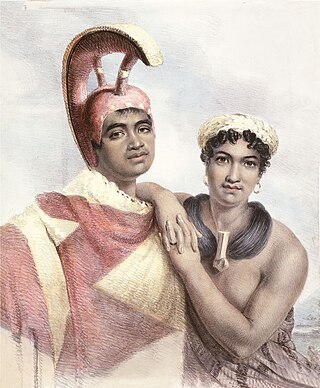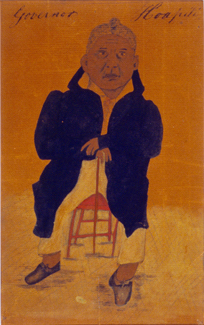Related Research Articles

Hawaii is an island state in the Western United States, about 2,000 miles (3,200 km) from the U.S. mainland in the Pacific Ocean. It is the only U.S. state outside North America, the only one which is an archipelago, and the only one in the tropics.

Ancient Hawaiʻi is the period of Hawaiian history preceding the unification in 1810 of the Kingdom of Hawaiʻi by Kamehameha the Great. Traditionally, researchers estimated the first settlement of the Hawaiian islands as having occurred sporadically between 400 and 1100 CE by Polynesian long-distance navigators from the Samoan, Marquesas, and Tahiti islands within what is now French Polynesia. In 2010, a study was published based on radiocarbon dating of more reliable samples which suggests that the islands were settled much later, within a short timeframe, in about 1219 to 1266.

Native Hawaiians are the indigenous Polynesian people of the Hawaiian Islands.

Kuini Liliha was a High Chiefess (aliʻi) and noblewoman who served the Kingdom of Hawaii as royal governor of Oʻahu island. She administered the island from 1829 to 1831 following the death of her husband Boki.

William Pitt Leleiohoku II, born Kalahoʻolewa, was a prince of the Hawaiian Kingdom and member of the reigning House of Kalākaua.

Miriam Auhea Kalani Kui Kawakiu o Kekāuluohi Kealiʻiuhiwaihanau o Kalani Makahonua Ahilapalapa Kai Wikapu o Kaleilei a Kalakua also known as Kaʻahumanu III, was Kuhina Nui of the Kingdom of Hawaii, a queen consort of both Kamehameha I and Kamehameha II, and mother of Lunalilo. In ʻŌlelo Hawaiʻi, Kekāuluohi means; "the vigorously growing vine". She adopted her secondary name Auhea, meaning Where, oh where, in memory of the death of Kamehameha I.

Harriet or Harrieta Keōpūolani Nāhiʻenaʻena (1815–1836) was a high-ranking princess during the founding of the Kingdom of Hawaii and the conversion of some of the ruling class to Christianity.
Abigail Maheha was a Hawaiian chiefess (aliʻi) of the Kingdom of Hawaii. At a young age, she was chosen to attend the Chiefs' Children's School taught by the American missionary Amos Starr Cooke and his wife, Juliette Montague Cooke, alongside her half-sister Jane Loeau and fourteen of her royal cousins.

Grace Kamaʻikuʻi Young Rooke was a Hawaiian high chiefess who was daughter of John Young, the chief military advisor during the formation of the Kingdom of Hawaii, and adoptive mother and aunt of a future queen consort.

Kaʻiminaʻauao was a Hawaiian high chiefess who was given in adoption to Queen Kalama and King Kamehameha III. She died of the measles at the age of three, during an epidemic of measles, whooping cough and influenza that killed more than 10,000 Native Hawaiians. Her elder brother and sister became King Kalākaua, and Queen Liliʻuokalani.

Abigail Kinoiki Kekaulike Kawānanakoa, also known as Princess Abigail Kawānanakoa and sometimes called Kekau, was a Native Hawaiian-American heiress, equestrian, philanthropist and supporter of Native Hawaiian heritage, culture and arts, who was born during the Territorial Period of Hawaii as a descendent of the Hawaiian royal family from the House of Kawānanakoa.

Ulumāheihei Hoapili was a member of the nobility during the formation of the Kingdom of Hawaii. He was a trusted military and political advisor to King Kamehameha I, known as "Kamehameha the Great". Although trusted with one of the last symbolic rites of the Hawaiian religion, he later became a supporter of Christian missionaries.

John Edward Bush, also known as John Edwin Bush, was a politician and newspaper publisher in the Kingdom of Hawaii.
Margaret Maiki Souza Aiu Lake was a hula dancer, kumu hula, hula teacher, and influential figure in the second Hawaiian Renaissance because of her revolutionary teaching techniques. Because of her work she was recognized as the "Mother of Hawaiian Renaissance." Many of her students became teachers themselves making her the "most important hula teacher of the 20th century."

Peleuli, formally Peleuli-i-Kekela-o-kalani, was a Queen consort of the Kingdom of Hawaii as a wife of king Kamehameha I.

Miriam Auhea Kekāuluohi Crowningburg Kamai was a Hawaiian high chiefess (aliʻi) during the Hawaiian Kingdom. She was a cousin of King Lunalilo and namesake of his mother Kekāuluohi who ruled as Kuhina Nui (premier) under Kamehameha III.

Winona Kapuailohiamanonokalani Desha Beamer was a champion of authentic and ancient Hawaiian culture, publishing many books, musical scores, as well as audio and video recordings on the subject. In her home state, she was known as Auntie Nona. She was an early proponent of the ancient form of the hula being perpetuated through teaching and public performances. Beamer was the granddaughter of Helen Desha Beamer. A cousin to Hawaiian Music Hall of Fame inductee Mahi Beamer, she teamed with him and her cousin Keola to form a touring North American troupe performing ancient hula and the Hawaiian art of storytelling. She was a teacher at Kamehameha Schools for almost 40 years, but had been expelled from that same school as a student in 1937 for dancing the standing hula. Beamer's sons Keola and Kapono are established performers in the Hawaiian music scene. Her grandson Kamanamaikalani Beamer is a professor at the University of Hawaii at Manoa and CEO of the Kohala Center. She ran a Waikiki hula studio for three decades. In 1997—indignant at proposals to cut Hawaiian curriculum from Kamehameha Schools—Beamer became the catalyst for public protest and legal investigation into Bishop Estate management, which eventually led to the removal or resignation of the trustees.

The spouse of the mayor of Honolulu is an unpaid ceremonial position. Those who have filled the position have been a reflection of the history of the islands. Several were of Hawaiian ancestry. Emma Fern was a Hawaiian chanter and dancer. Kini Kapahu Wilson was not only a proponent of women's voting suffrage, but also found fame as a hula dancer who performed for heads of state around the world.
Haʻaheo Kaniu or Kaniuʻopiohaʻaheo was a high chiefess (aliʻi) and member of the royal family of the Hawaiian Kingdom. She was also known as Lydia Haʻaheo Kaniu.
Dalani Tanahy is an American artist specializing in the Hawaiian art of creating kapa, fabric made by beating bark. Tanahy creates kapa for artistic and ceremonial purposes and teaches courses and workshops. She is the founder of Kapa Hawaii, an organization dedicated to reviving and preserving the art of kapa creation.
References
- ↑ Staton, Ron (August 24, 2003). "Native blood and custom clash". Honolulu Star-Bulletin.
- ↑ Regelman, Kazz (November–December 2016). "All in the Family". Maui Magazine. Retrieved 15 September 2023.
- ↑ Regelman, Kazz (November–December 2016). "All in the Family". Maui Magazine. Retrieved 15 September 2023.
- ↑ Regelman, Kazz (November–December 2016). "All in the Family". Maui Magazine. Retrieved 15 September 2023.
- ↑ "Hawaiian Dictionaries". wehewehe.org. Retrieved December 23, 2017.
- ↑ "The Life of the People". Ke Ola Magazine. November 1, 2011.